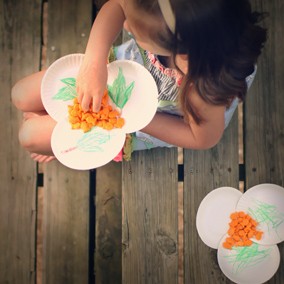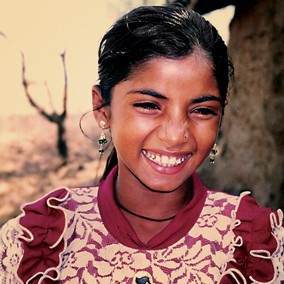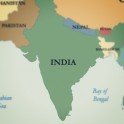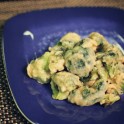Hi. My name means “happiness.” I live in Gujarat (goo-jah-raht), State in central India. Called the “bow people,” my ancestors were fierce warriors who used bows and arrows not only to defend our land from outsiders, but also to hunt wild tigers and other animals. Today most men are farmers, but some, like my father, still use bows and arrows for hunting.
My stick house has a clay tile roof. In the surrounding field, we grow grains like wheat, barley, millet, and corn. Most days, I spend my time helping Mother. Every morning, I walk to the well in the middle of the village, fetch water, and carry it home in a jar balanced on my head. Then my mother, sister, and I begin preparing dinner. It takes a long time since we make everything by hand. I grind the corn into flour used to make chapatis (cha-pah-teez), a flat bread like thick tortillas. While Mother fries the chapatis over a hot fire, my sister grinds the spices needed to make curry powder, a spice for flavoring our meat and vegetables. We even make our own plates by weaving together large, round leaves with sticks. At dinnertime, we eat on the ground outside our home. Using our hands, and scoop up the food with the chapatis. After a hard day’s work, I am tired and ready for bed. I sleep on a charpoy (chahr-poy), a cot-like bed made of wood and rope netting.
Two important people in our village are the headman and the witchdoctor. The headman leads our village and makes decisions about many things. The witch doctor can control evil spirits. Many of my people are afraid of the “evil eye,” when an envious person has the power to cast a spell on someone just by staring into his eyes. This spell could make us get sick or cause something bad to happen. The witch doctor gives parents special charms to hang around their children’s necks for protection.
Even though we work hard, Bhil families love celebrating. During festivals, we sing songs and perform dances that tell stories of brave warriors who have gone before us. I can teach you the Ghoomar (goo-mahr), a women’s circle dance. As men sing and play instruments, the ladies twirl to the music, colorful skirts billowing out, hands moving gracefully. The dance keeps gets faster and faster.
Every year, Bhil families travel to another part of India for the Banashwar (bah-nee-shwahr) fair. Hundreds of us camp along the river in homemade tents. In the evening, we talk and sing around the campfire. At this huge festival, there are magic shows, acrobats, actors performing plays, street vendors selling food, and even a Ferris wheel!

Family Activity:
Create your own leaf plate and eat like the Bhil people. Gather three, thin paper plates (not Styrofoam) and three toothpicks for each child. Using crayons and colored markers, draw leaf outlines and veins to make the plates look like leaves. In all three plates punch two holes (1 inch apart), approximately ½ inch in from the edge. Fan out the three plates so the holes overlap, making a triangle shape with the holes. Weave the three toothpicks up through the holes and then back under, much as you would pin cloth together with a straight pin. Serve a snack on your leaf plates that you can eat with your hands.
Option for young children: Color one paper plate to resemble a leaf. No toothpicks required.
Pray:
• Bhil families mix together Hindu worship of idols, spirit worship of things in nature, ancestor worship, and witchcraft. Pray that God will reveal Himself to them as the one true and living God.
• Only 1% of the 12 million Bhil people have ever heard of Jesus. Pray for God to raise up global workers to live and serve among them. Pray that the few Bhil believers will share their faith boldly with family and friends.
Central Bhil
Vegetable Pakora
Vegetable Fritters
South Asia
Preparation Time: 30 minutes | Serves: 4-6
Ingredients
- 1/2 pound vegetables (cauliflower, broccoli, potatoes, onions, green peppers, etc.)
- 1 cup whole wheat flour
- 1/4 teaspoon salt (or to taste)
- 1/2 teaspoon cayenne pepper
- 1/8 teaspoon mint extract
- vegetable oil
- tomato sauce, ketchup, or mint chutney






